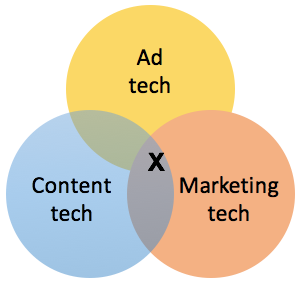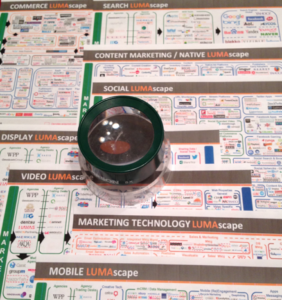 Back to Blogs
Back to Blogs
Platforms to Optimize Digital Marketing
A sea of choices, but not for everybody

Not only are there quite a lot of platforms laying claim to digital marketing optimization, but jargon is often layered so thick that it’s hard to tell which does what.
At the highest level it may be helpful to think of the space we’re looking at as a Venn diagram whose primary poles are ad-tech, content-tech and marketing-tech.
Wily vendors have figured out that just like in ancient treasure maps, “X” marks the spot and might well be at the intercession of all three. Hence the fair amount of consolidation that continues to rearrange this landscape.
On the other hand, full convergence maybe not be right for every customer or for all channels. A key question is whether hospitality CMOs should be attempting to directly execute with their own in-house teams in such a complex space and if so for which channels.

For those inclined to “double-click” LUMA Partners continuously revises and publishes exceedingly good infographics called LUMAscapes that show the key players in our Venn diagram with such great detail that sometimes a magnifying glass is in order.
In order to make the field intelligible we’ll be doing much the opposite of LUMA and simplify matters to make them understandable in four ways:
- We’ll only mention selected leaders in each key area
- In cases where we feel a vendor is present in multiple areas but more relevant in one than another we’ll pick and choose with great abandon
- We’ll depart from official jargon when specialist jargon obscures understanding
- We’ll ignore a great many solutions that are already fairly well understood such as ESPs or basic content authoring technologies
First, an argument for letting trusted professionals take care of you
Because this field is evolving so fast, even those of us who make a living foraging in it need to keep going back to re-learn what the latest trends, capabilities, winners and losers are.
Of course the lessons taken from one context may not apply to another. For example, local targeting (in the sense of tailoring campaigns based on live user locations) may or may not be applicable. London at 3am, on a smartphone? Yes, maybe that person is looking for a hotel that very night. The same person some hours later on the same smartphone may now be planning a beach getaway a week or two later with the person they met the night before. And what is true for a trivial targeting exercise like this one, is most certainly true for strategic advice: take it if the circumstances fit.
In preparing this article we interviewed some of the most progressive leaders in digital marketing and before we jump into naming vendors and technologies it may be best to share some of their cautions.
Wayne Johnson is CEO of GatewayMedia.us, an agency whose leading edge practices have not only reshaped the political advertising space, but is also a perennial winner of awards ranging from “Best Use of Facebook Advertising”, “Best Online Campaign” to radio, TV and other creative work.
Wayne suggests hospitality executives should exercise caution before tinkering with any of the tools mentioned farther below unless they’re a major brand with the budgets, expert staff and “throw-weight’ to have a go on their own.
“In travel and hospitality you have platforms like Adara and Sojern who want their clients to succeed because their business model depends on it. That's not necessarily true of either Google or Facebook when unskilled users attempt to manage them directly. These platforms are utterly Darwinian and agnostic about whether your ads are programmatically driven out of the News Feed by financial services promotions or political ads. Your business might not die from competition… but could be killed by an algorithm.
Most companies probably should not even be thinking of stepping outside of the travel-specific platforms. Instead, they should be ensuring that wherever travelers encounter their brand, it is speaking with the same "voice", that brand loyalty is not put at risk for a slight uptick in one metric on the dashboard. Today, brands are destroyed one click at a time.
In response marketing the focus is invariably on what works. GatewayMedia.us probably places 75% of our spend on Facebook, Pandora and Hulu because, for our clients, the metrics work. The downside is that looking only at response rates can create a type of 'metrics myopia', a field of view so tightly focused on how a campaign is performing that we lose sight of why it is performing. Platforms that commoditize data are seldom subjected to the kind of multivariate research analysis that tells us which attributes in combination are driving the decision-making process.”
Wayne C. Johnson,
CEO, GatewayMedia.us
The alternative to taming complex platforms in-house, of course, is to engage professional services, an area with a great many options.
So you still want programmatic, data-driven, dynamically optimized marketing but don’t have the staff needed?
One way is to pick a reputable agency (or a platform that includes agency services) and rely on their full-service offerings.
This is easier said than done for various reasons. One is the relative lack of agencies with truly massive experience. To avoid conflicts agencies often restrict themselves to one major client per vertical which sounds good until you realize that that means few agencies have a truly complete view of an industry.
In a pinch, asking a platform vendor which agents do a credible job using their tools is an excellent starting point.
You assign your budget. The agency helps you take your first-party data (what you know about your customers/prospects) and process it through a data management platform that enriches it with third party data to create customer segments, and you’re ready to start spending… no, not yet.
The typical digital marketing process is not terribly different than the classical media campaign workflow:
⇒ Segment customers ⇒ Plan ⇒ Generate matching creatives ⇒ Pre-buy/allocate budget ⇒ Consume inventory ⇒ Track/fine tune performance ⇒ Attribute/reconcile ⇒ Re-Plan
Assuming the pre-requisites are satisfied, then yes, you can start spending. Your agency’s trade desk will take action on your behalf, and (the good ones) will help you fight fraud with “Inventory Quality Vendors” such as Integral Ad Science or White Ops. Agency staff will start with buying inventory from premium channels and then execute programmatic ads that attempt to avoid cheap inventory and open ad exchanges.
On the other hand, if you’re feeling brave… follow us into the rabbit hole
Digital Marketing Hubs:
- Segment your user data after combining first-, second- and third-party data.
- Support workflow and collaboration
- Conduct intelligent orchestration, sequencing, multivariate testing
- Optimize yield
A lot of ink could be spilled debating this area but there’s little doubt that the enterprise leader is Adobe’s programmatic advertising platform. Agencies that have the expertise and staff may choose point solutions such as Marin Software just for search engine marketing.
As a holistic platform it’s hard to beat the Adobe Marketing Cloud. Adobe’s portfolio includes: Profiles and Audiences, Asset Sharing, Media Optimizer, Analytics, Audience Manager, Primetime TV platform, and (after their Tumri acquisition) Dynamic Creative Optimization.
Adobe is consistently ranked highest by Gartner, Forrester etc and is putting forth a serious effort both in terms of acquisitions and true product engineering to create a platform that is simultaneously modular and integrated.
Facebook – The Biggest (and growing) Outlier
While digital marketing hubs do a great job, Facebook is a complete exception. Facebook is a galaxy unto itself and its own interfaces can not only help you target people when on Facebook but also once they leave and go on to other web properties.
In other words Facebook is bot medium and platform. Don’t waste effort on third parties – either your team or your agency should really engage Facebook directly.
Now if you feel really adventurous and want to try mix a digital marketing optimization cocktail yourself, here are some samples
Data Management Platforms
[X+1] or BlueKai – scale and capabilities that are hard to beat. They help take your first-party data (what you know about your customers/prospects) and enriche it with third party data to create customer segments.
Demand Side Platforms
MediaMath or DataXu – These platforms enable buyers of digital advertising inventory to manage multiple ad exchanges and data exchange accounts through one interface.
Overall SMB solution
HubSpot is worth a look as the all-in-one digital marketing platform pioneer, but only for SMBs.
Video, display and native ad platform
BrightRoll offers leading programmatic video, display, and native advertising solutions, including a demand side platform and an exchange that powers digital advertising at vast scale.
Persuasive/multivariate ad generation
Companies like Persado take what used to be a bunch of fruitless debates around word choice and makes it all testable. Even if it were just for giving us back all those hours, they deserve a try.
Programmatic creative plaforms
PaperG offers excellent Creative Management and Dynamic Creative Optimization. After all, what would be the point of getting all the “plumbing” sorted out if you didn’t have a near infinite variety of targetable content to push through it?
So as promised, a quick fly-by of optimization platforms in digital marketing. There are a great many excellent companies not mentioned here and “mileage may vary in actual use.” So with a final caveat that this is just an introduction to start a conversation rather than a set of specific endorsements, go forth, create well, yield optimally and convert at will!
Published in print in Hospitality Upgrade's Summer 2016 issue
 Previous Post
Previous Post